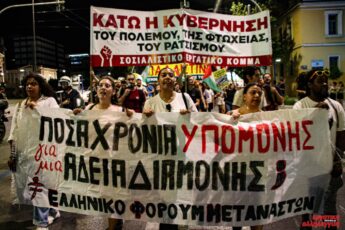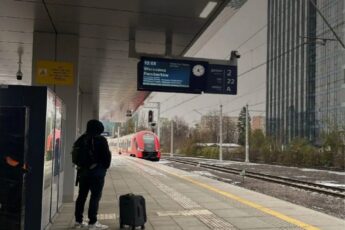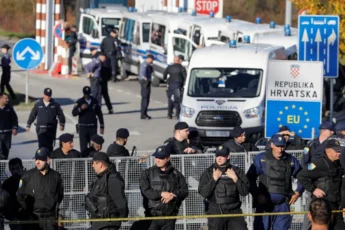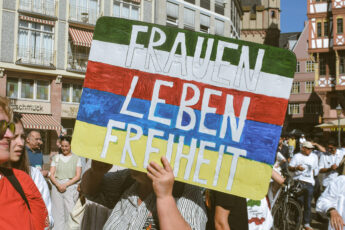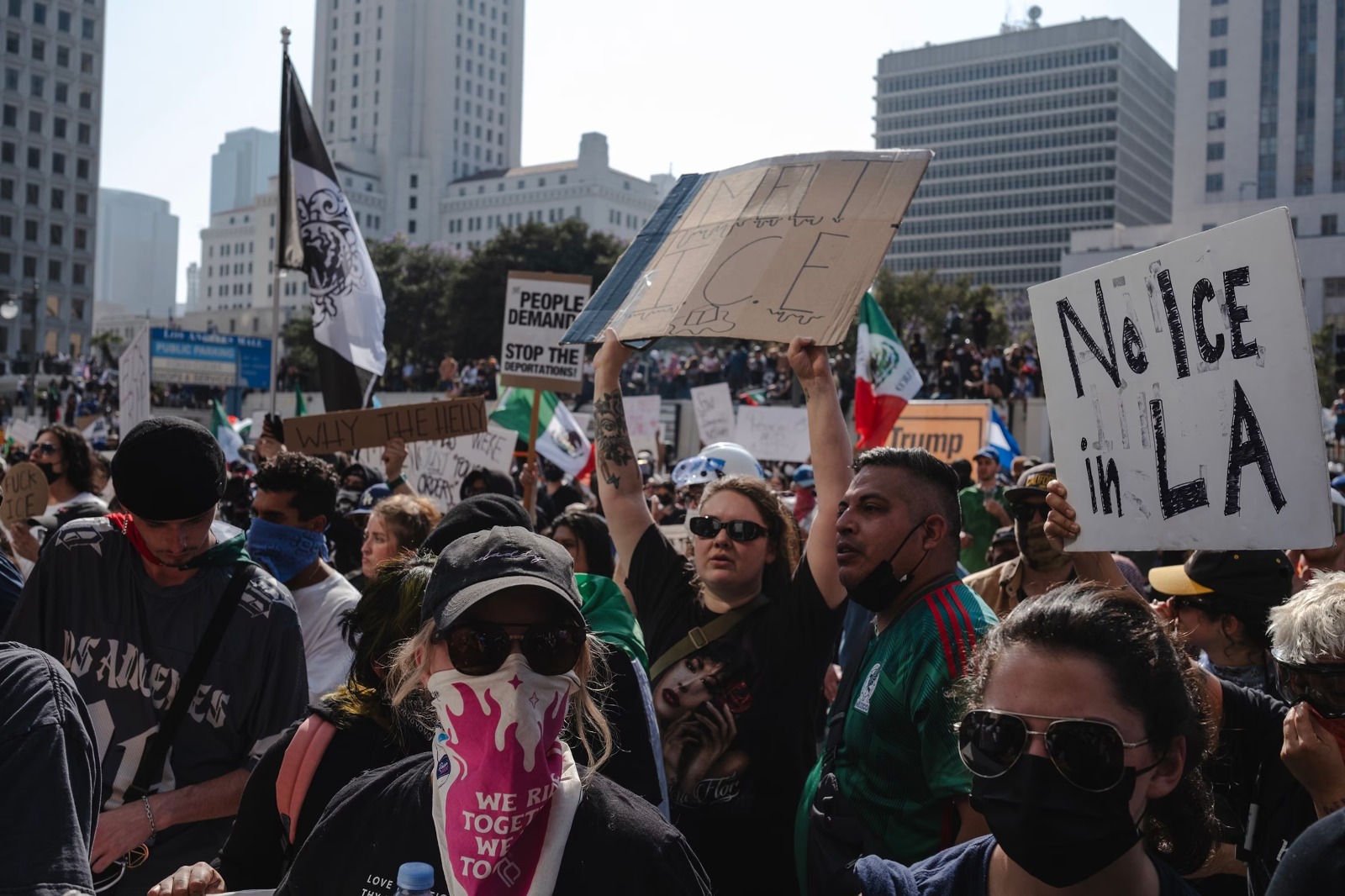
Since the beginning of his second term, Trump has delivered on his promises to hunt down migrants, accelerating the rate and scale of raids in workplaces and courthouses, deporting them even to countries other than those of origin, with no possibility of appeal or access to legal counsel. Recently, the so-called “Big Beautiful Bill” not only carried out a massive transfer of wealth from the bottom up, but also granted ICE—the agency in charge of migrant deportation—a $45 billion budget. This new budget places the immigration agency as the 16th most well-funded military force in the world (after Canada and ahead of Italy), allowing ICE agents to operate with impunity, as a police force controlled directly by the president and shielded from any legal restraint to spread terror in the streets. ICE raids are often indiscriminate, but there have been instances of ICE targeting migrant workers who were trying to unionize. It is this new approach that generated the response of workers and activists in Los Angeles in mid-June, leading to massive protests and direct actions to prevent ICE from accessing workplaces. Since then, Trump has inaugurated “Alligator Alcatraz,” a detention center for undocumented migrants built in one of the most remote areas of the country, while the Supreme Court has left the application of birthright citizenship entirely to the discretion of individual states. Moreover, the Trump administration has been canceling programs that allowed hundreds thousands of migrants to enter the United States through work visas, thus actively forcing them into an illegal status. To comment on these developments, we interviewed Nanzi Muro, an activist and artist working with the Tribuno del Pueblo on the border between San Diego and Tijuana. For years, Nanzi has been fighting against the racist policies that have targeted migrants inside and outside the U.S. border well before Trump took office and she explains how, similarly to what is happening in Europe, the borders of the United States are increasingly being externalized and pushed further south by paying Latin American countries — not only Mexico, but also Colombia, Panama (among others) — to stop migrants. Nanzi witnessed the protests that erupted in Los Angeles last month in response to ICE deportations and then spread across the country, and, in the interview, she tells us what groups, associations, and anti-racist networks are now doing to support migrants and oppose Trump’s fierce policies. The brutal repression is undermining the ability to protest in the streets, pushing activists to focus primarily on providing legal assistance to migrants. Trump’s assault on healthcare, education, and public spending – combined with his warmongering agenda masked as peace – has led to the rise of new movements – No Kings, 50501, Hand Off etc. – against authoritarianism, the centralization of power and wealth in the hands of billionaires, the war in Gaza and migrant deportations. The challenge these movements now face is to overcome the fragmentation of individual struggles and build a truly collective, mass-scale mobilization. For now, migrants working in farms in California announced a three-day worker-led strike between July 16 and 18 against ICE and its violence.
TMC: Could you please introduce yourself and tell us a bit about your background and your involvement with Tribuno del Pueblo?
Nanzi Muro: My name is Nanzi Muro. I’m an artist and activist based in the borderlands between San Diego and Tijuana. I grew up going back and forth between these two beautiful cities—two cultures, two languages, but really one single community. The only thing dividing us is the border. Growing up in such a heavily militarized environment deeply shaped my perspective. That’s where my activism and art came together—my creative work is a response to what I’ve witnessed. I’ve been volunteering and working with Tribuno del Pueblo for the last five years. I first got involved by contributing photography, and over time I began helping with writing articles, designing informational pamphlets, and creating much of the graphic design you see in the publication. What drew me to Tribuno del Pueblo is their core belief that no human being is illegal. They advocate for those whose voices often go unheard, especially migrants. Most importantly, they tell truths that mainstream media often ignores.
TMC: How have the living conditions for migrants changed from your point of view, particularly since the Trump administration?
Nanzi Muro: Unfortunately, I have to say that what we’re seeing now isn’t entirely new. These issues have existed for decades. But under Trump, the cruelty became more overt. His administration planted a deep sense of fear. He simply doesn’t care about migrant communities, and many people who support his policies seem to enjoy seeing others live in fear. People who can’t defend themselves are now being targeted more than ever, and that’s why community support is critical. For example, in San Diego, many organizations are now asking for volunteers to accompany people to court. Often, migrants are summoned for seemingly innocuous appointments, only to be detained when they arrive. We’ve seen this happen repeatedly. Now, there’s at least the option for migrants to request Zoom hearings instead of going to court in person, which helps reduce the risk of detention. But this isn’t well publicized. Organizations like Chirla, Tribuno del Pueblo, Border Angels, and the American Friends Service Committee here in San Diego are doing incredible work to spread this information and support the community. Another thing I’ve noticed is that people who never used to protest are now taking to the streets. They’re fed up because ICE is violating constitutional rights, rights that apply to everyone in the U.S., not just citizens. There’s no due process, and it’s infuriating. Many of us are angry and frustrated, feeling like there’s only so much we can do.
TMC: Is the movement against migrant deportations connected in any way with movements like “No Kings” or others like 50501? I’m thinking about broader, more general protests against the authoritarian turn under the Trump administration.
Nanzi Muro: Well, I wouldn’t say we’re directly connected to the No Kings movement, but we can definitely draw historical parallels. What’s happening now echoes moments in history, whether it’s Nazi Germany, what’s happening in Israel, or even the U.S. during slavery. Trump wants to return to those eras. You can see it in the way he talks, the policies he tries to implement. We’ve seen this before: what happened to the Chinese community, to the Japanese who were sent to internment camps. What’s happening now is just a continuation, and we have to look back at history to understand the present. Some of the organizations I work with—like Tribuno del Pueblo, Border Angels, American Friends Service Committee—they’ve been in the movement for decades, some for over 50 years. So what’s happening now isn’t new to them or to us. What is new is that more white people are now speaking up, mainly because, for the first time, their privileges are being threatened. People of color have been facing these issues forever. Like me, I’ve crossed the border my entire life and been racially profiled every time. That’s not new. What’s different is that now more people are noticing. In some cases, yes, people are coming together. For example, there was an ICE raid in South Park, a mostly white, middle-class neighborhood here in San Diego. The community forced ICE to leave. That kind of solidarity matters. So yes, there’s more awareness, but it’s complicated. For many white folks, it’s about defending privileges. For us, it’s about survival.
Social media has become a powerful tool to broader awareness. People themselves have become the reporters. When they document and post what’s happening, the big media outlets follow. The phone has become a key tool in the fight, people are recording and sharing everything. That said, I personally don’t work closely with groups like No Kings. I’m more involved with long-standing grassroots organizations that have been supporting migrants since long before Trump. For example, two years ago, there were thousands of migrants trapped between the two border walls here: no food, no water, no bathrooms. The government didn’t intervene. It was the community and local orgs that stepped in. What people don’t realize is how militarized the border has become. Now there are actual military troops deployed at the U.S.-Mexico border. And we’re not even talking about the fact that migrants are being stopped far before they reach the U.S., in Panama, in Colombia. The U.S. border isn’t just between the U.S. and Mexico anymore. It’s been pushed southward, and no one’s talking about it. It’s clear that the U.S. government gives money to governments like Mexico to stop migrants before they reach the U.S. border. That’s already happening. But it doesn’t stop there. There’s also the Darién Gap, between Panama and Colombia. It’s a really dangerous region. If you look into it, you’ll see how many people are trying to cross it and how different governments are now working together to stop people even there. There’s a lot of tension. So the problem is no longer just about migrants arriving at the U.S. border. We should also be asking why people are migrating in the first place. For many of us, life here is just survival. We’re working nonstop just to pay rent and bills. Many of us are struggling with mental and physical health, so it’s hard to keep up with everything going on. You open Instagram or the news, and there’s something new every day. It’s overwhelming.
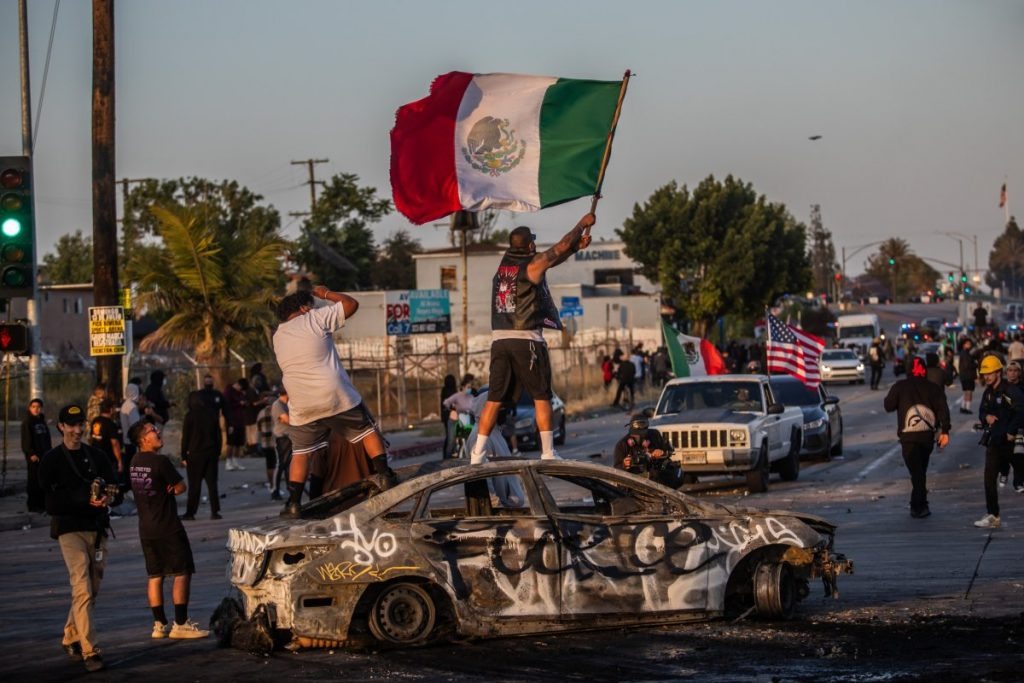
TMC: You said that this situation at the border has been going on for decades, but if we look at the numbers, have deportations actually increased? What is new?
Nanzi Muro: Let me tell you about a recent case here in San Diego, in the South Park neighborhood. One Friday evening, there was a community celebration – graduations, restaurants full of people – and ICE raided one of the restaurants. They claimed to have a signed warrant from a judge authorizing them to arrest everyone inside. Citizens, non-citizens, everyone. How is that even legal? Aren’t they supposed to be arresting criminals? Since when does working in a restaurant make someone a criminal? In the end, four people were arrested. Two of them were still in detention the last time I checked. One chose voluntary deportation, and we lost track of the fourth person. This is happening more and more: people are just picked up off the street. It’s racial profiling, plain and simple. And these detention centers – people call them las hieleras (the iceboxes) – are freezing cold. No blankets, no food. There are videos showing women who’ve lost their pregnancies while detained. I could give you many cases. There was one student, only 16 or 17 years old, wrongly identified by ICE. He was an excellent student, loved by his community. The entire neighborhood rallied to defend him. People are tricked into signing forms, they’re told, “If you sign this, we won’t deport you.” It’s a lie. But it’s not just the border. In San Diego, we’re seeing visa revocations for people coming back from vacation. Green cards being taken away. People are being attacked from every direction. You don’t even need to be undocumented to be targeted. A few years ago, I went to a museum in Germany. They had posters listing restrictions for Jews. What Trump is doing now is the same thing. The policies may look different, but the message is the same: exclusion, dehumanization, and fear. Right now, if you’re not actively supporting Trump, you’re seen as his enemy and they come after you. Social media has become another way they attack people. A lot of people have set their Facebook and Instagram profiles to private because even there, they’re being watched and targeted. And it’s not just undocumented people. Even U.S. citizens are being profiled. A few months ago, there were tourists detained, one here in San Diego and another from Canada. They were just visiting, and still they ended up in detention centers. This government doesn’t care. And the roots go back. Reagan paved the way for Trump to be where he is now. And now we have a president with 34 felony charges and still, nothing happens. That’s where the “No King” movement comes in: because no one should be above the law. The system is failing. The courts aren’t protecting us, and the Democratic Party hasn’t stepped up.
TMC: And what has been the reaction among the organizations you collaborate with regarding the removal of birthright citizenship?
Nanzi Muro: Well, in California, we’re not directly affected yet, so there hasn’t been an immediate mobilization. But we are definitely talking about it. There are lots of workshops and webinars happening, spaces where people are gathering to discuss and learn about these issues. A lot of lawyers are stepping in, too, doing community education and offering support where they can. Some organizations offer free legal aid, but there are too many cases and not enough people to handle them all. Right now, the focus is on helping family members who are already in detention centers, getting them out, finding legal support, and sharing information. That’s where people’s energy is going. As for what will happen with the end of birthright citizenship, I think it’ll be like what happened with abortion rights. Some states will still allow it, while others will completely block it. So people will travel to those states to give birth, just like people now travel for abortion access. It’s going to create deep inequalities. Trump, honestly, he played the long game. In his first term, he focused on putting people in power who would help him push through all these changes in the second term. You don’t need to be a political expert to see that. It’s clear. And terrifying.
TMC: What is the role of the Black community in these demonstrations against deportations?
Nanzi Muro: There’s actually a lot of support from the African-American community, especially from nonprofit groups, but unfortunately, you don’t hear much about it in the news. They’ve been working with us even before this most recent wave of repression. But I’ll be honest: there’s also been some tension. For example, in Chicago, there’s been a lot of division, especially because the mayor is Black, and he’s being attacked from both sides, both from within the Black community and outside of it. So it’s complicated. The same goes for Los Angeles: the mayor there is also African-American and she has been trying to support the community, to be there for the people. So yes, there are people from the Black community standing up and saying, “This is not okay.” And that solidarity is really important, because whether people realize it or not, these policies are affecting everyone. What the government is doing – this current administration – is creating division. They’re sowing division among communities by spreading the message that migrants are the problem, that migrants are what’s wrong with this country. But they are not succeeding. Latin American migrants are definitely more united now. One thing we’ve really noticed is how strong the youth are becoming in this moment. A lot of young people are frustrated by what’s happening, and they’re stepping up. For example, if a family has a small business – a restaurant or a street vendor stand – it’s often the children, teenagers even, who are taking over. Kids who are 14, 16 years old are now running their parents’ business so their parents can stay home and avoid the risk of deportation. Some older siblings, like 18- or 20-year-olds, are becoming the heads of their households. There’s even been cases where people choose to deport themselves before ICE catches them, because it feels safer that way.
TMC: Can you say more about what the grassroots groups are doing and how they are organizing?
Nanzi Muro: Many organizations are working 24/7 on the frontlines. One of them is Chula. Let me give you an example. We went with other journalists to cover the protests in Los Angeles, and there was a woman who had been given a paper—an official notice—to appear at an immigration office. But because of the protests and everything else, the office was closed. The paper didn’t even specify what the appointment was for. So, as a community, we shared the document with lawyers from Chula, and they informed us that the paper was actually an order to arrest and deport her on the spot. So we suggested that it was better to leave. And the lawyers assured us they would do everything they could to help her. But honestly, we don’t know what happened after that, we lost track of her. We also have contacts in Reynosa, one of the most dangerous cities in Mexico. Migrants there are in extreme danger, not only from government actions but from cartels and impostors pretending to be authorities. Some people pretending to be officers are targeting vulnerable migrants, and that makes things even worse. Another significant contribution was given by Eric Canales, an activist who passed away and who used to work to recover the bodies of migrants who died at the border – families are still searching for them. There have also been deaths in detention centers. And with the recent ICE raids, it’s become almost impossible to track where people are being taken. In general, all the grassroot organizations here have been in this movement for years, not just since Trump. These are not reactive groups. They’ve been there before, during, and after. Some of them are even based in different states and countries. One organization I want to highlight is Unión del Barrio. They wake up every day at four or five in the morning and go into low-income neighborhoods to check if ICE is around. If they see ICE vehicles, they alert the community immediately: “Don’t go outside! ICE is here!” They describe the cars, share the location. Also, these deportations are having a huge impact on the education system: low-income communities are being denied access to education, it’s impacting them deeply. A lot of students with visas have had them revoked, sometimes just because they spoke out about Palestine.
TMC: Thank you Nanzi. Is there anything else you’d like to add?
Nanzi Muro: Yes. We need to come together as a community and learn our history, not just what happened in the U.S., but globally. People need to understand: we have the power. We are the majority, and we shouldn’t live in fear.


